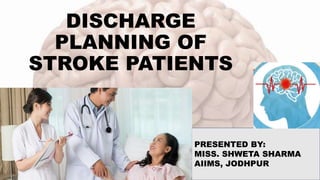
Discharge planning of stroke patients.pptx
- 1. DISCHARGE PLANNING OF STROKE PATIENTS PRESENTED BY: MISS. SHWETA SHARMA AIIMS, JODHPUR
- 2. WHAT IS STROKE???? A stroke occurs when a blood vessel in the brain ruptures and bleeds, or when there’s a blockage in the blood supply to the brain. 24-03-2023 2
- 3. 24-03-2023 3
- 4. TYPES OF STROKE Transient ischemic attack (TIA) Ischemic stroke Hemorrhagic stroke 24-03-2023 4
- 5. 24-03-2023 5
- 6. 24-03-2023 6
- 7. 24-03-2023 7
- 8. 24-03-2023 8
- 9. 24-03-2023 9
- 10. 24-03-2023 10
- 11. 24-03-2023 11
- 12. 24-03-2023 12
- 14. 24-03-2023 14
- 15. PHYSIOTHERAPY • Exercises to keep elbows, shoulders, and other joints loose • Watching for joint tightening (contractures) • Making sure splints are used in the correct way • Making sure arms and legs are in a good position when sitting or lying • Check every day for pressure sores at the heels, ankles, knees, hips, tailbone, and elbows. 24-03-2023 15
- 16. DIET After a stroke, the patient may have: • Problems using arm or hand, making it difficult to eat and drink. • Problems with memory and thinking, which might mean the patient forgets to eat and drink. • Loss of appetite • Swallowing problems (dysphagia) 24-03-2023 16
- 17. If patient has problems with arm or hand, or with memory and thinking, an occupational therapist can help with aids and with strategies to help remember. If patient has dysphagia, a speech pathologist can recommend strategies to help eat and drink safely. The patient may need food and drinks with a different consistency. 24-03-2023 17
- 19. 24-03-2023 19
- 21. 24-03-2023 21
- 22. BOWEL CARE • Pick a regular time, such as after a meal or a warm bath, to try to have a bowel movement. • Be patient. It may take 15 to 45 minutes to have bowel movements. •Try gently rubbing stomach to help stool move through your colon. •Avoid constipation. 24-03-2023 22
- 23. SPEECH AND LANGUAGE THERAPY •Stroke survivors may have trouble speaking, finding words, or understanding what other people are saying. This is called aphasia. •Therapy may include repeating words as well as reading and writing exercises. 24-03-2023 23
- 24. Top 5 Speech Therapy Exercises for Patients Who Have Suffered a Stroke 24-03-2023 24
- 25. To improve communication : Keep distractions and noise down. Keep voice lower. Move to a quieter room. Allow plenty of time for the person to answer questions and understand instructions. Use simple words and sentences. Ask questions in a way that can be answered with a yes or no. When possible, give clear choices. Do not give too many options. Break down instructions into small and simple steps. 24-03-2023 25
- 26. Repeat if needed. Use familiar names and places. Make eye contact before touching or speaking if possible. Use an electronic device, such as a tablet, computer or cell phone, to show pictures to help with communication. 24-03-2023 26
- 27. PSYCHOTHERAPY Stroke can cause chemical changes in the brain that affect the way a person thinks, feels, and behaves. • Talk therapy • Positive psychology • Mindfulness • Cognitive behavior therapy (CBT) 24-03-2023 27
- 28. OCCUPATIONAL THERAPY • Holistic approach- mind, body, spirit and emotion • Basic ADL such as feeding, grooming, bathing, dressing and toileting, managing medication. • Instrumental activities of daily living such as cooking, driving • Range of motion including improving muscle strength, tone and control and coordination. • Cognition skills such as thinking, processing and interpreting visual and spatial (space) information. • Movement and mobility when performing ADL. 24-03-2023 28
- 29. HOME CARE Keep walkways and floors clear of clutter. 24-03-2023 29
- 30. Make sure electrical cords are safely tucked away. 24-03-2023 30
- 31. Secure rugs with non skid pads under the rugs or by taping rugs to floors. 24-03-2023 31
- 32. Keep common items such as dishware, food items, or medication within easy reach and design utensils in assistive way 24-03-2023 32
- 33. Plate guards help keep food on the plate. 24-03-2023 33
- 34. Consider installing rails or assistive bars near the toilet or shower. 24-03-2023 34
- 35. FOLLOW UP • Follow the scheduled appointments after discharge. • Close follow-up is important to stroke rehabilitation and recovery. • Call emergency right away if you have any of the following symptoms of stroke: Weakness, tingling, or loss of feeling on one side of face or body Sudden double vision or trouble seeing in one or both eyes Sudden trouble talking or slurred speech Trouble understanding others Sudden, severe headache Dizziness, loss of balance, or a sense of falling Blackouts or seizures 24-03-2023 35
- 36. 24-03-2023 36
